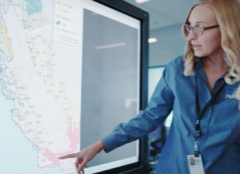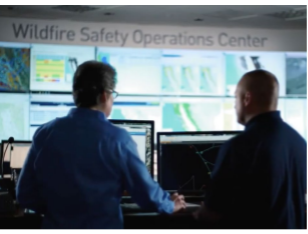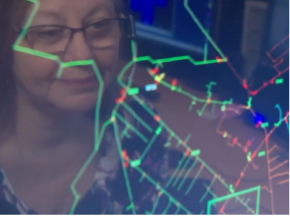In recognition of this growing threat and the urgent need to end the devastating effects of wildfire on our communities and ecosystems, PG&E has undertaken a comprehensive and multi-faceted portfolio of efforts to eliminate the risk of catastrophic fire. Our investments in wildfire mitigation span several key initiatives that seek to eliminate controllable sources of ignition through asset monitoring and vegetation management, protect against heightened risk from external conditions through proactive de-energization schemes, and rapidly identify and suppress any ignitions that do occur in proximity to our assets.
PG&E's Wildfire Mitigation Plan outlines our comprehensive strategy to stop catastrophic wildfires. As part of this strategy, PG&E has a goal to underground 10,000 miles of distribution lines where fire risk is the highest, with an additional goal of minimizing disruptions to customers from Public Safety Power Shutoffs (PSPS) and Enhanced Powerline Safety Settings (EPSS).
 |
PS1. Automating PSPS events to improve safety and decrease customer impact |
The current process for de-energizing and re-energizing portions of the grid for Public Safety Power Shutoff events is highly manual in nature, limiting the ability to respond in real-time and granularly target events based on time to evolving conditions on the grid. |
|
|
Why is this important? Public Safety Power Shutoffs are critical to PG&E’s ongoing efforts to eliminate ignitions across the system. By proactively deenergizing our equipment in these areas, we can effectively reduce the likelihood that weather-related damage to those assets will result in an ignition, thereby keeping our customers and communities safe. While PSPS has been an effective tool for reducing ignitions, improving our ability to more granularly target events and respond more rapidly to the evolution of local conditions would not only enhance our ability to eliminate ignitions but also could enable PG&E to better target outages to minimize impacts to surrounding homes and businesses. |
|
|
What is the current state and its primary limitations? Today, PG&E risk models utilize a broad range of inputs, including local environmental conditions, forecasted wind and weather patterns, and vegetation load surrounding PG&E assets, to assess localized wildfire risk. Based on the output of these models, PG&E plans PSPS events in locations with increased probability of heightened wildfire risk and notifies customers of upcoming outages. Grid operators manually intervene to de-energize affected portions of the grid and subsequently restore power when updated risk models indicate that the threat of ignition has subsided. Given that today’s process for calling and executing PSPS events involves multiple manual steps, PG&E is unable to incorporate the most current data available due to the required time to process and react to changing conditions. Innovations to provide greater situational awareness at the grid edge, to communicate evolving conditions back to grid operators, and to enable automated responses to identified risks could result in more targeted PSPS events that dynamically respond to dynamic environmental conditions.
Primary limitations include:
|
|
|
What are the desired outcomes from R&D? Novel technologies, including AI/ML, to:
|
|
 |
PS5. Enhancing fire spread modeling to address increasing urban conflagration risk |
| Current wildfire modeling approaches used by PG&E and across the utility sector do not fully account for the risk of urban conflagration, where structures and other property (vehicles) act as fuel and enable structure-to-structure ignition. In high-density environments, embers and radiant heat can ignite homes, vehicles, and landscaping, leading to the rapid spread of fire through communities. Utilities and municipalities are unable to effectively model the impacts of various mitigation strategies (e.g., defensible space, hardening) under urban firestorm scenarios. | |
| Why Is this important?
Urban and suburban areas have traditionally been treated as low-risk zones for wildfire spread due to assumptions about limited natural fuel. However, recent devastating fires such as the 2017 Tubbs Fire, 2021 Marshall Fire, 2023 Lahaina Fire, and wildfires in Los Angeles have demonstrated that homes and infrastructure can become the primary carriers of fire. In particular, urban conflagration is being driven by ember storms that are spread by windy conditions, combined with flammable building materials. Recent analysis showed that there are over 1,100 communities across 32 US states that share characteristics with those that have been recently impacted by urban wildfires. The spread of flames through structures is vastly different from that in wildland locations, making it difficult to assess such wildfires the same way. Failure to account for these dynamics leaves communities, cities and utilities with less accurate risk assessments. A utility's operational decisions, such as de-energization or infrastructure hardening, depend on these models, and any underestimating of risk in urban and wildland-urban interface (WUI) environments results in the prioritization of less risky locations for mitigation work. |
|
| What Is the current state and its primary limitations?
PG&E employs a suite of sophisticated wildfire risk models, including:
While these models are critical tools for operational planning, they are primarily focused on the role of utility infrastructure in ignitions and how fires start and spread with wildland fuels. These models provide insufficient guidance for utilities, first responders, and planners who seek to mitigate fire risk in urban and WUI settings.
Primary limitations include:
|
|
| What are the desired outcomes from R&D?
Novel technologies, including AI/ML, to:
|
|
 |
PS7. Expanding capabilities and coverage of continuous fault monitoring |
| While capable of identifying and geolocating faults, current continuous monitoring technologies are unable to determine when an identified fault will result in failure or to extrapolate observed patterns to predict when and where a fault is likely to occur in the future. Additionally, there is currently no cost-effective solution for extending existing capabilities to the secondary and service level, limiting visibility into asset conditions and PG&E’s ability to effectively triage evolving threats across the entire system. | |
| Why is this important?
PG&E utilizes a combination of continuous monitoring technologies and comprehensive routine inspections to identify evolving risks across our overhead system. While these methods are effective at identifying and locating faults, current technologies lack the ability to accurately assess when an identified fault may result in failure or to predict when and where future faults may occur. As a result, our ability to triage interventions based on risk level is limited, as is our ability to address evolving conditions to avoid a fault before it occurs. Enhanced predictive and diagnostic capabilities that could provide comprehensive coverage of the overhead system would help PG&E to further reduce wildfire risk across our service area.
|
|
| What is the current state and its primary limitations?
The ongoing rollout of next generation smart meter technology will provide PG&E with greater insight into evolving conditions across our electric system. With this technology and vendor partners, we have seen early successes in accurately detecting, categorizing, and precisely locating anomalies on the grid that were previously invisible to grid operators unless a failure occurred. In addition to new smart meter technology, we have also rolled out other continuous monitoring devices, including onsite sensors to detect overheating in transformers and pole sensors that collect and monitor a wide range of data related to condition of distribution poles and the assets attached to them. The deployment of this suite of technologies provides PG&E with more data than ever on conditions across much of our system. While this visibility is intensely helpful in understanding the current state of many of our assets, today’s technologies cannot leverage this visibility into either specific, actionable insights or extrapolative, predictive intelligence. Additionally, while monitoring capabilities now extend across much of our system, gaps remain in our ability to continuously monitor services and secondaries.
Primary limitations include:
|
|
| What are the desired outcomes from R&D?
Novel technologies, including AI/ML, to:
|
|
 |
PS9. Optimizing deployment of forest management interventions |
The lack of relevant advanced analytics and valuation methodologies to accurately assess the wildfire risk reduction potential, environmental benefits, and economic value of various land use treatment investments limits PG&E's ability to optimally deploy a broader portfolio of potential interventions and to quantify the benefits of these investments across multiple stakeholders. |
|
|
Why is this important? Healthy forest ecosystems can reduce wildfire risk by increasing forest resilience and reducing wildfire spread and consequences risk. The industry currently lacks the ability to analyze the impact of various land treatment investments, such as controlled burns or selective logging, on wildfire risk reduction and other desired outcomes and to quantify the size of various value streams created through those investments. The ability to adopt a more targeted, data-driven approach and to comprehensively quantify the value of various forest management interventions could not only broaden the portfolio of tools at PG&E's disposal but also could expand the potential pool of stakeholders willing to support or co-fund these efforts. This more holistic approach to forest management could in turn lead to better outcomes across a range of PG&E objectives, including mitigating ignition and consequence risk, increasing reliability, minimizing emissions, and supporting the overall health of our communities and the planet. |
|
|
What is the current state and its primary limitations? Today's solutions for analyzing, optimizing, and valuing forest land treatments across a wide range of desired outcomes, including improving public safety, asset protection, reliability, and hydro system value, are insufficient. There is no robust and scalable optimization and valuation methodology to accurately assess the myriad benefits that healthy forests can provide for an electric utility or to evaluate how forest restoration investments might compare against other wildfire mitigation alternatives along key outcomes of interest. Beyond consideration of outcomes relevant to electric utilities, modeling capabilities that would enable PG&E to quantify the full range of value streams created for all impacted stakeholders also are not currently available.
Primary limitations include:
|
|
|
What are the desired outcomes from R&D? Novel technologies, including AI/ML, to:
|
|
|
Submit Application
Please fill out the entirety of the form below to the best of your ability.
Browse Ideas
Review your submitted projects.
|
Terms and Conditions | Contact Us: noreply@brightidea.com |



